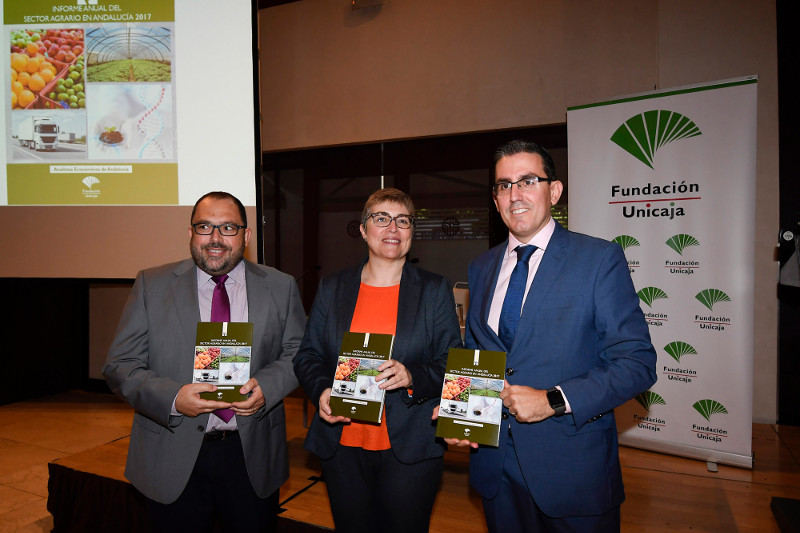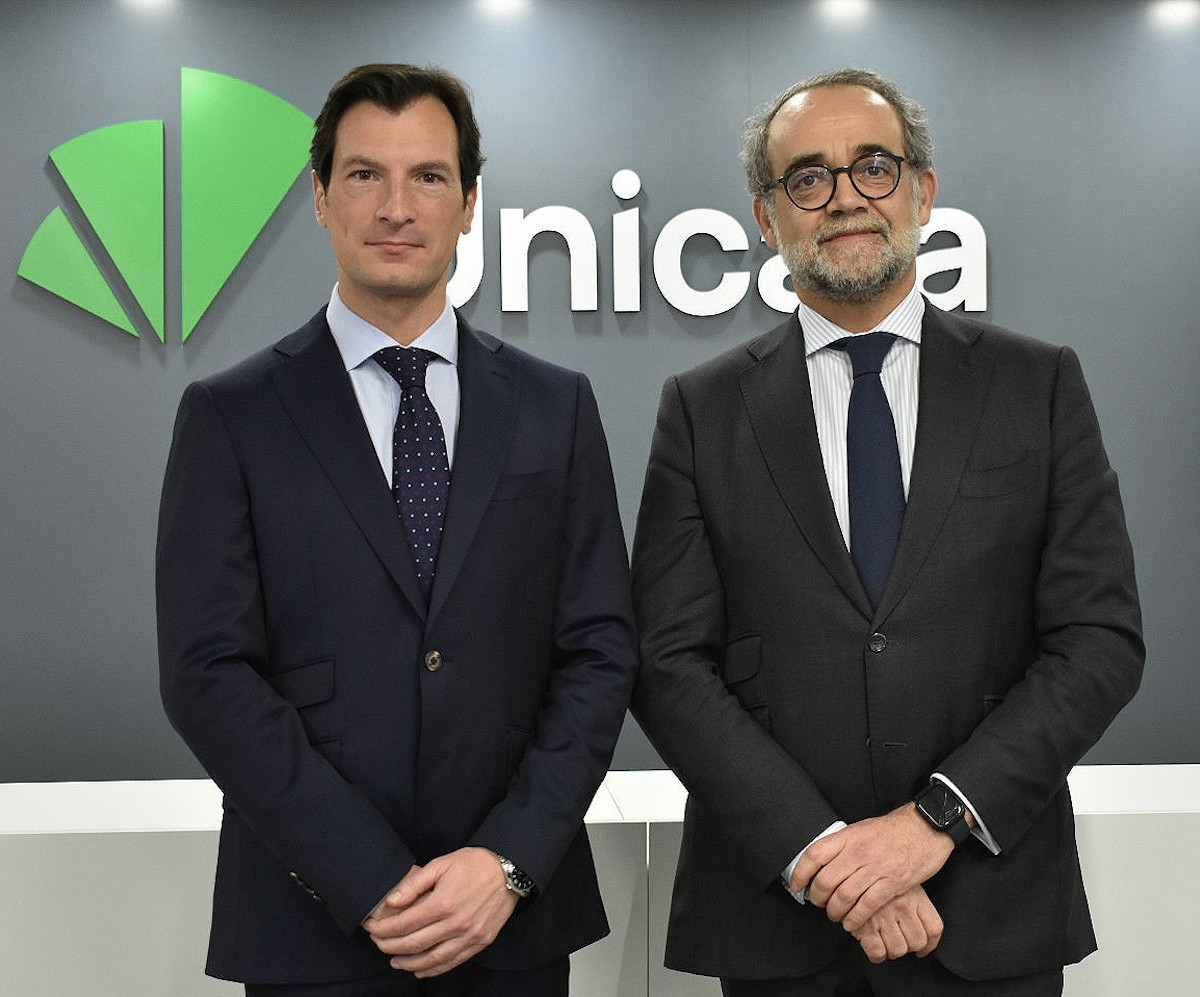In 2017, Andalusia’s agricultural income grew by 6.9%, reaching 9,247.2 million euros, accounting for about one third of the national agricultural income.
The agricultural production reached 12,399.7 million euros, up 5.6% with regard to 2016, and represents about 25% of the national production. Among its components, crop production (around 85.5% of the agricultural production) grew by 5.5% and livestock production, by 6.2%.
The 28th edition of the ‘Annual Report of the Agricultural Sector in Andalusia’, corresponding to the year 2017, prepared by Analistas Económicos de Andalucía (Grupo Unicaja’s research company) and sponsored by Fundación Unicaja, was presented today in Seville.
The main goal of this Report is to provide an analysis of the agricultural and agri-food sector in Andalusia, key pillars of its economic structure, not only because of its contribution to the generation of wealth and employment (representing altogether 7% of the regional GVA and 10% of the employment), but also because of the role they play in the territorial cohesion and balance, helping to maintain population in rural areas.
The ‘Annual Report of the Agricultural Sector in Andalusia 2017’ was presented today in Seville, in an event chaired by Sergio Corral, General Manager of Fundación Unicaja, and Rafael Peral, General Secretary of Agriculture and Food of the Regional Government, and with the participation of Felisa Becerra, coordinator of the report.
The Report is structured as follows: after a short introduction, the document is divided into four chapters. The first one focuses on the dimension of the agricultural sector, analyzing, inter alia, the general economic environment, the development of the Common Agricultural Policy (CAP), the evolution of the employment market and the evolution of agricultural farms and productions.
The second chapter presents estimations of macroeconomic data in 2017, one of the main contributions of the work, and a detailed analysis is provided on the evolution of the agricultural income in Andalusia and in each province, as well as about agricultural production (crops and livestock production). Chapter 3 is devoted to the agri-food industry, trying to highlight the importance of this industrial branch for the Andalusian economy and for the national economy.
Attention is paid to its main figures, such as turnover, employment, business structure, foreign trade of agri-food products, and food consumption and distribution. Finally, the Report includes a chapter about the main findings and conclusions.
The Report includes three especially relevant charts: 1) Evolution of the prices of farm land in Andalusia; 2) Agricultural insurance in Andalusia; and 3) Agricultural cooperatives in Andalusia: productive units and employment.
The main results included in the Report, related to 2017 estimations of agricultural income and production, are shown below, as well as the main aspects related to the agri-food industry:
Agricultural income
In 2017, Andalusia agricultural income stood at 9,247.2 million euros, 6.9% up with regard to the previous year, according to the estimations of Analistas Econónomicos de Andalucía. This amount represents 33.2% of the Spanish agricultural income.
The number of jobs of the Andalusian agricultural sector in 2017 is 7.0% higher than the previous year average, representing nearly one third of the jobs of the agricultural sector in Spain.
As for its provincial distribution, Almeria continues to be the province with a higher contribution to the Andalusian income (24.3%), together with Jaen (17.8%) and Seville (14.4%). Cordoba and Granada also have shares over 10%. In comparison with 2016, the agricultural income has increased in general, with rises over the regional average in Jaen, Cordoba, Cadiz and especially in Huelva (20.3%), whereas in Almeria the income has grown at a similar pace to that of the whole region.
Agricultural production
The value of the agricultural production (crops and livestock) has reached 12,399.7 million euros in 2017, representing 25.2% of the Spanish production. This amount represents an increase of 5.6% over the previous year, which is explained by a rise in prices (6.8%), given that productions decreased by 1.1%.
The increase is due both to the rise in crop production (5.5%) and in livestock production (6.2%), with the former representing 85.3% of the value of the Andalusian agricultural production. In particular, the value of crop production reached 10,578.1 million euros in 2017, accounting for 36.9% of the national production. With regard to 2016, an increase of 7.0% in prices has been registered, whereas productions fell by 1.4%.
As per cultivations, vegetables are a reference for Andalusia and account for 38.3% of the value of the regional crop production, and about 43% of the horticultural production in Spain. Olive oil represents more than 80% of the production value in Spain, and 26.1% of the regional crop production. Industrial crops and fruits represent more than one third of the value of the national production. With regard to 2016, an increase has been noticed in the production value of nearly all crops, especially -because of their contribution to the regional production- non-citrus fruit crops (12.3%) and olive oil (12.1%), with the production value of vegetables growing by 2.7%.
In real terms, we should mention the increases in the production of fruits, cereals, industrial crops or wines. As for prices, significant rises have been seen in some of the main crops in Andalusia, such as vegetables (6.6%), olives (7.3%) or olive oil (19.9%).
By provinces, Almeria represents 24.3% of the value of the vegetal production in Andalusia, followed by Jaen and Seville (16.3% and 16.1% respectively), with Granada and Cordoba contributing around 12% each. The production value has grown in six provinces, with rates higher than the regional average in Huelva (14.8%), Cadiz (13.8%), Jaen (7.8%) and Almeria (6.5%). Prices have shown a general growth, with the exception of Granada, whereas productions are up in Huelva, Cadiz and Seville.
With regard to livestock production, its value has reached 1,821.6 million euros in 2017 (9.7% of the national production), growing by 6.2% in comparison with the previous year. This increase is due, mainly, to the rise in prices (5.7%), especially in beef and veal and poultry meats, eggs and milk, with production growing in real terms by 0.5%, increasing the bovine and swine stocks.
As for the provincial distribution, Seville (23.0%) and Cordoba (19.8%) are those which make a higher contribution to the value of the livestock production in Andalusia, with contributions slightly over 10% in the provinces of Malaga, Huelva and Granada. In 2017, the value of the production has increased in five of the Andalusian provinces, with rises over the regional average in Cordoba (19.4%), Granada (13.9%) and Malaga (10.8%). Prices have gone up in general, and over 10% in Granada, Malaga and Cordoba, while productions have increased in Granada, Jaen, Huelva and especially in Cordoba (6.3%).
Agri-food industry: main figures and business fabric
Agri-food industry is one of the most significant activities of the industrial sector in Andalusia, providing 25.7% of the turnover of the regional industry and 24.8% of employment (around 16,700 million euros and 51,800 workers). Andalusia represents 15.1% of the turnover and 13.4% of the employment of the sub-sector in Spain, ranking second in the Spanish autonomous communities.
The apparent productivity (measured as a the ratio between the turnover of business and the number of jobs) of the agro-industrial sector in Andalusia is estimated to be 322,508 euros, higher than the 285,979 of Spain, with Andalusia being the second Spanish region with higher turnover per employee.
Disaggregation by sectors shows that oils and fats concentrates 41.8% of the total turnover of the agro-industrial sub-sector, followed by the manufacture of drinks (14.5%) and the meat industry (12.5%). With regard to occupation, the sector which provides a higher number of employments is bread and pastry (27.6% of the total of jobs in agro-industry), followed by the meat industry (16.3%) and by oils and fats (14.3%). It is worth highlighting that the industry of oils and fats contributes to the national aggregate with 63.1% of the turnover and with 57.3% of the jobs in that area in Spain.
As per the productive fabric of the agri-food industry, as at 1 January 2017, there were in Andalusia 5,332 companies, 3.8% more than in the previous year (3.5% in Spain). This involves a change in the downward trend observed since 2006. These companies represent 23.1% of the total in the Andalusian manufacturing industry (17.9% in Spain), as well as 18.4% of the companies of the sub-sector in Spain, a percentage higher than that of the industrial aggregate (14.2%) or the whole regional productive fabric (15.3%).
Considering size, micro-companies (with no employees or with less than 10 employees) represent 81.5% of agri-food companies in Andalusia. This percentage rises to 96.2% in the aggregate of the regional productive fabric (excluding agricultural companies). Andalusia has 129 companies with more than 50 employees (medium-sized and big companies). In comparison with the previous year, companies with less than 10 employees and those with more than 200 have been those with the highest growth rates, around 9%.
As per activity areas, manufacturing of bread, bakery and pastry products is the one with a higher number of companies (44.4% of the sector), followed by oils and fats (14.6%) and by meat industry (10.8%). At the same time, because of its contribution to the national aggregate, oils and fats (46.9% of the Spanish companies), fruit and vegetable processing (25.1%) and bakery and pasta (22.5%) must be highlighted.
Agri-food trade balance
The agri-food trade balance (agricultural sector and food industry) has registered in 2017 a positive balance of 6,629.8 million euros, 5.6% higher than in 2016. The value of agri-food exports has grown to 10,787.0 million euros, representing a 9.2% rise year-on-year. This amount accounts for 34.9% of the total value exported by the region, as well as for 23.6% of the Spanish exports, with Andalusia being the first Autonomous Community by export value of agri-food products.
The main product exported by Andalusia is virgin olive oil (18.5% of the value of agri-food exports), with sales reaching 1,996.6 million euros in 2017, 11.2% more than in 2016. Other exports to be highlighted are: fresh or chilled tomatoes, sweet peppers, olive oil and its fractions, prepared or preserved olives, strawberries or cucumbers, with an increase in the exported value of all of them, save olives.
76.4% of agri-food exports in Andalusia are sent to the European Union, with Germany (15.1% of the total), Italy (14.0%) and France (12.4%) as the main destinations. In comparison with 2016, the value of exports to the European Union has increased by 9.8%, with remarkable increases in sales to Italy and Portugal (25.8% and 13.4% respectively).
Seville (25.5%) and Almeria (25.1%) gather around half of the total value exported by the region, followed by Huelva (12.1%), Malaga (10.5%) and Cordoba (10.2%). In 2017, the increase in sales has been general, with growths higher than the regional average in Cordoba, Jaen, Malaga, Seville and Granada.
Food consumption and distribution
Food consumption in Andalusia grew by 0.3% in 2017 (-0.7% in Spain). Also, the total expenditure in food stood at 11,207.5 million euros, a year-on-year 2.9% increase, higher than that registered in Spain (0.6%).
The foods which are most consumed in Andalusia are fresh fruits (13.2% of the total amount of foods), followed by liquid milk (10.0%) and mineral water (9.4%), highlighting also the consumption of sodas and soft drinks (8.6%), fresh vegetables (8.3%), meat (7.2%), dairy products (6.1%) and bread (5.5%). Meat concentrates 19.9% of the expenditure in food, followed by fish (12.9%), dairy products (8.9%) and fresh fruits (8.5%).
Download informe anual del sector agrario en Andalucía 2017
Download tablas y gráficas del informe anual del sector agrario en Andalucía 2017



